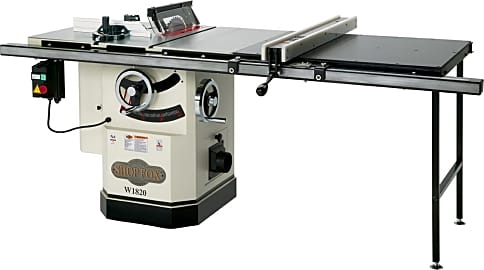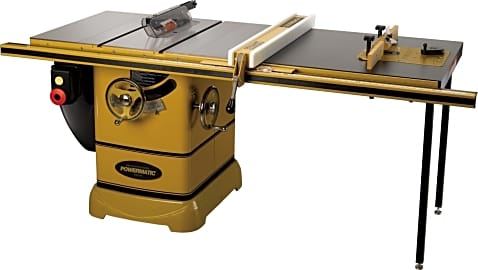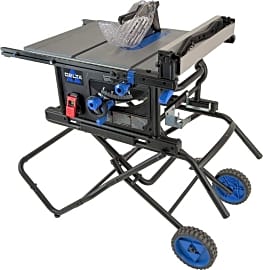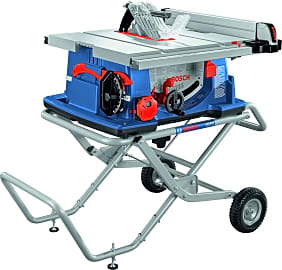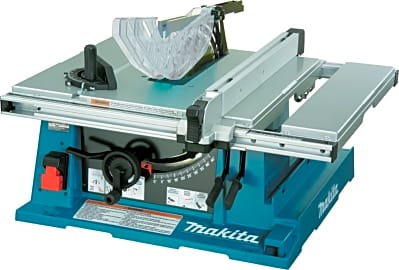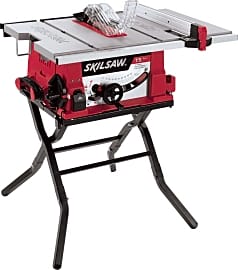The 10 Best Table Saws

This wiki has been updated 40 times since it was first published in June of 2015. When it comes to ripping plywood or making precise, repetitive cuts through lumber, there's little doubt that the tool you want on your side is a table saw. Our selections for this category include heavy-duty, cabinet-style models intended for permanent installation in wood shops, as well as compact, portable models with collapsible stands, which are great contractors hopping between job sites. When users buy our independently chosen editorial selections, we may earn commissions to help fund the Wiki.
Editor's Notes
November 05, 2020:
A series of upgraded models released over the past year made for a fairly busy round of updates, with half of our previous selections being replaced. We switched out the discontinued DeWalt DWE7480, a portable 10-inch model, for the new DeWalt DWE7485 — an 8-1/4-inch option that, despite having a smaller maximum cut depth than the DWE7480, features a slightly better bevel capacity and a no-load speed of 5,800 RPM, compared to the DWE7480’s 4,800. For DeWalt fans who have their sights set on a larger model, it’s worth noting that the 10-inch DeWalt DWE7491RS did manage to maintain its spot on our list.
The discontinued Metabo HPT C10RJ was also replaced by the Metabo HPT C10RJS, although a side-by-side comparison of their features, through the company’s website, made it difficult to determine what improvements this new model is offering. We also reached out to Bosch to try to clear up what differentiators separate the new Bosch 4100XC-10 from the previous Bosch 4100-10, but a representative was unable to provide immediate answers, and an email response wasn’t received within 24 hours, in time for this update to be published. However, two obvious upgrades included with the 4100XC-10 seem to be a new, oversized kill switch with built-in, low-voltage protection, and an increased cut capacity of 30 inches — a significant jump from the 4100-10’s 25 inches.
We also exchanged the Shop Fox W1819 for the Shop Fox W1820 — a similar, heavy-duty, cabinet-style option that stands out with its 50-inch cut width. And finally, we ended up eliminating the Rockwell RK7241S, due to availability issues, and used that vacancy to rank the Delta 36-6023 — a portable, 10-inch unit with a smart, collapsible stand and a 3-1/2-inch cut depth that’ll make quick work of 4x4 posts.
November 28, 2019:
During this round of updates, we eliminated the Jet Deluxe – due to availability issues, and replaced the Bosch 4100-09 with its recent predecessor – the Bosch 4100-10. We also added the Rockwell RK7241S – a portable option with a laser guide, and the Metabo HPT C10RJ – a powerful model equipped with soft-start functionality.
A few things to keep in mind for this category:
Power: Nothing’s worse than a saw that can’t keep up with your workflow. You want a tool that can tear through whatever you feed it (at a safe pace, of course) in quick fashion. To get a sense of how hard these saws can go to work, some companies will advertise the no-load speed of their saw’s motor. However, this really isn’t the best metric when it comes to comparing apples to apples in this respect. Since belt-driven options (like most job-site models you’ll come across) will have a certain amount of slip, the real number you’re looking for is arbor speed. In the case of direct-drive table saws, the no-load RPM rating and arbor speed should be unified.
Portability: Some of the options in this category – like the Skilsaw 3410-02 and the Rockwell RK7241S – can fold right up and fit into the trunk of your Honda Civic, but others – like the Shop Fox W1819 and the Powermatic PM2000 – are large, heavy offerings that require considerable assembly, and are intended strictly for permanent use in a workshop. If you need something closer to the former, for your own ergonomic sake, pick an option that includes a stand, or budget to purchase one separately.
Safety: As fantastic as they are for ripping lumber, table saws have an ugly reputation for cutting off fingers. In the interest of preventing accidents like this, most models have some selection of safety features, like blade guards or anti-kickback pawls. None of that, however, can touch the brilliant innovation behind the SawStop Professional, which can cause a blade to completely stop and retract into the table three to five millisecond after it touches human skin.
Getting A Great Table Saw
For ripping beams and cutting smaller sheets of wood, a smaller table saw is the smart move.
A table saw is a powerful tool that makes short work of even large pieces of lumber, allowing you to make rip cuts down the grain of boards, beams, and even entire sheets of plywood. No carpentry shop or professional construction site is complete without a table saw. Deciding which saw is best suited to a given home workshop, furniture production factory, or building site is an important decision and merits careful consideration.
The obvious starting point for an analysis of which saw is best suited to the needs of a given person (or company, school workshop and so forth) is the budget at hand. Basic units – which are small, but still capable of many common tasks – can still be relatively expensive tools, and top-of-the-line table saws – which are overbuilt and ready for industrial use – can definitely come with price tags that are simply prohibitive for some users. It'll be up to you to balance the facts of your financial situation against the value the tool might offer you, and decide what price point to shop at, accordingly.
With top quality saws come features that some people may find well worth the extra investment, substantial though it may be, and thus our discussion starts with pricier models. At the top price range for table saws, you can often get a saw with safety technology that will automatically halt its blade the instant it encounters human flesh. (The process literally takes but a few milliseconds.) The knowledge that your fingers and hands are safe from major injury caused by a rapidly rotating, razor sharp blade is more than convincing enough for many people to invest in these technologically marvelous table saws.
However, with proper use, table saws are generally safe tools, advanced blade stopping technology not needed. Therefore considering a saw without such safety features is fine for the cautious DIY user or for the professional carpenter and/or builder. Take into careful account the actual table size of the table saw you are considering. If you are going to be completing rip cuts in large sheets of plywood, then you need a saw with a table large enough to support these big pieces of lumber.
For ripping beams and cutting smaller sheets of wood, a smaller table saw is the smart move. When you can easily move a table saw around a work site, it means less time and effort spent moving around heavy piles of lumber and more time actually cutting the wood into the size you need.
And no matter the size of your prospective table saw, make sure it features an easily adjustable fence so you can quickly alter its position to accommodate various sizes of lumber.
The Basics Of Table Saw Use And Safety
The first step to take when using a table saw is to don all the appropriate safety gear that a responsible operator should use. This includes, at the bare minimum, eye protection and thick work gloves. It's also a good idea to protect your ears with ear muffs or earplugs and to consider a mask that will cover your mouth and nose to prevent the inhalation of fine saw dust particles.
This includes, at the bare minimum, eye protection and thick work gloves.
While your table saw is unplugged, take the time to clear and clean the work surface, removing any debris that could negatively impact the smooth path of the wood you will be cutting. Then, lower or raise the blade to where the blade gullet (the curved section between each blade tooth) is equal with the top of the piece of wood to be cut. Also, make sure that your saw's dust exhaust port is clear and open and that a bag is in place to catch any excess sawdust.
Make sure the table saw's fence is in the proper position and is locked securely, and then place the lumber to be ripped near the blade, but without any contact. It's now time to power up your saw.
Move the wood to and then "through" the spinning saw blade slowly and steadily. It's alright to use your hands while you're still at least a foot or so from the blade, but once the end of the board or sheet nears the blade, you should use a pushing stick to keep the wood moving and to keep your fingers away from the blade. Even an experienced carpenter can have a lapse in concentration or a slip that can lead to serious injury.
As your board nears the end of its cut, watch out for the kickback that can occur when a table saw sends a section of wood flying back at the operator. You can keep a pushing stick firmly held against the wood to reduce the risk of a kickback, but also try to stand aside from the potential "flight path" in case the wood gets away from you anyway.
A Brief History Of The Table Saw
For centuries, the job of the sawyer was, quite simply, to saw logs into lumber. Working in two-man teams, a pair of sawyers would use massive saws -- called whipsaws or pitsaws -- to cut felled trees into workable planks with their own muscles as the motive power. The job was exhausting and often dangerous, yet necessary to create the precious lumber used to build everything from homes to railroad bridges.
For centuries, the job of the sawyer was, quite simply, to saw logs into lumber.
By the late 18th century, a new tool had been created that would eventually have the sawyers out of work: the circular saw. These early rotating saws were powered by a range of different forces, often including running water or wind, and sometimes driven by animal power. By the early 1800s, the sawmill was replacing the saw pit and its hardworking manual sawyers.
The advent of ever better motive power that came with 19th century developments led to ever more efficient and ever more compact power saws. The first recognizably modern table saws date to the latter decades of that century. With compact and powerful electric motors developed and refined throughout the 20th century, tables saws were widely available and were both compact enough for home use, yet powerful enough for nearly any lumber ripping task.


